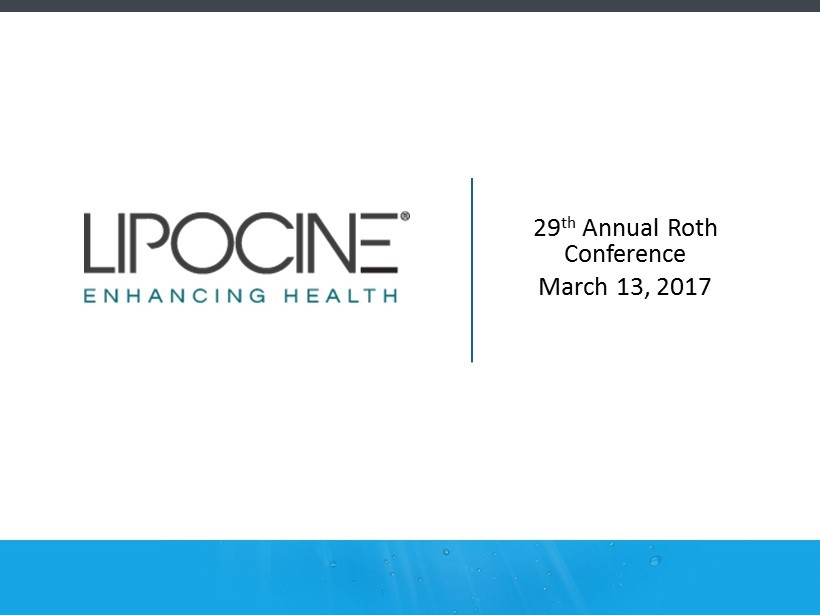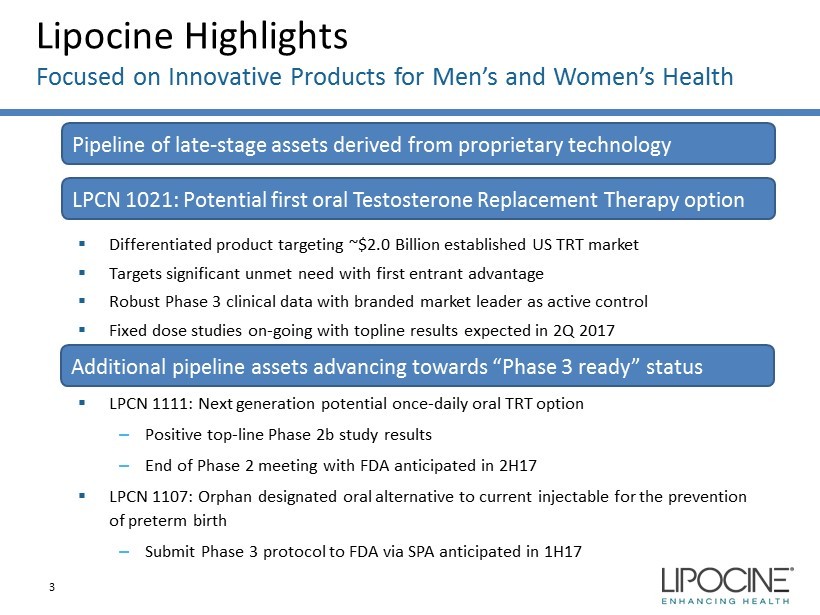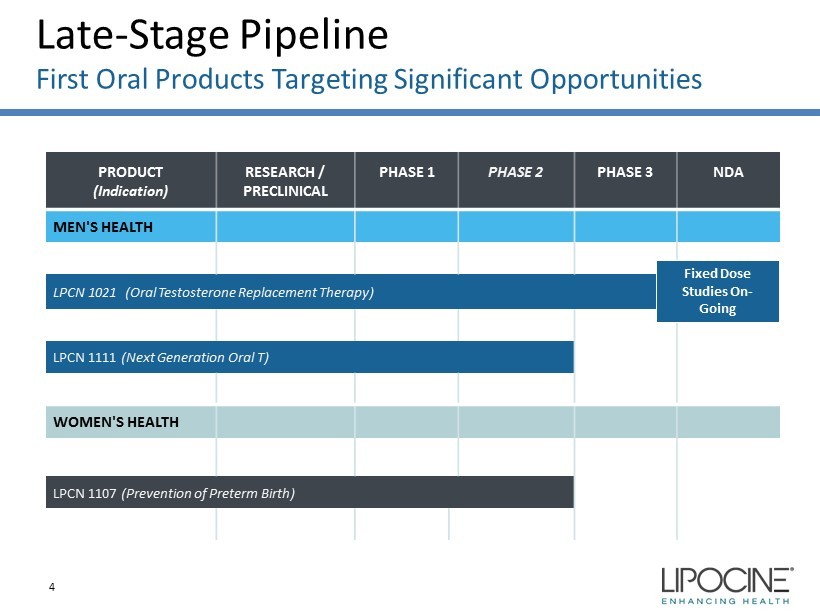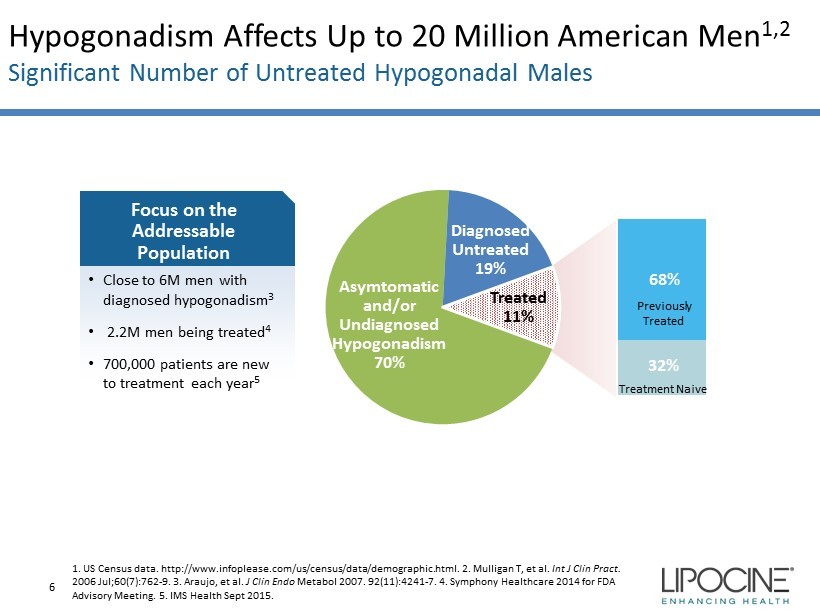Attached files
| file | filename |
|---|---|
| 8-K - 8-K - Lipocine Inc. | v461474_8k.htm |
Exhibit 99.1

29 th Annual Roth Conference March 13, 2017

Forward Looking Statements This presentation contains forward - looking statements about Lipocine Inc. (the “Company”). These forward - looking statements are made pursuant to the safe harbor provisions of the Private Securities Litigation Reform Act of 1995. These forward - looking statement s relate to the Company’s product candidates, clinical and regulatory processes and objectives, potential benefits of the Company’s product c and idates, intellectual property and related matters, all of which involve known and unknown risks and uncertainties. Actual results may d iffer materially from the forward - looking statements discussed in this presentation . Accordingly, the Company cautions investors not to place undue reliance on the forward - looking statements contained in, or made in connection with, this presentation . Several factors may affect the initiation and completion of clinical trials, the potential advantages of the Company’s product candidates and the Company’s capital needs. Among other things, the projected commencement and completion of the Company’s clinical trials may be affected by difficulties or delays. In addition, the Company’s results may be affected by i ts ability to manage its financial resources, difficulties or delays in developing manufacturing processes for its product candidates, preclinical an d toxicology testing and regulatory developments. Delays in clinical programs, whether caused by competitive developments, adverse events , p atient enrollment rates, regulatory issues or other factors, could adversely affect the Company’s financial position and prospects. Pr ior clinical trial program designs and results are not necessarily predictive of future clinical trial designs or results. If the Company’s pro duc t candidates do not meet safety or efficacy endpoints in clinical evaluations, they will not receive regulatory approval and the Company will no t be able to market them. The Company may not be able to enter into any strategic partnership agreements. The Company’s commercial success de pends on its ability to manufacture, market and sell products without infringing the proprietary rights of third parties. Operating ex pense and cash flow projections involve a high degree of uncertainty, including variances in future spending rates due to changes in corpora te priorities, the timing and outcomes of clinical trials, competitive developments and the impact on expenditures and available capital from li cen sing and strategic collaboration opportunities. If the Company is unable to raise additional capital when required or on acceptable t erm s, it may have to significantly delay, scale back or discontinue one or more of its drug development or discovery research programs. The Co mpa ny is at an early stage of development and may not ever have any products that generate significant revenue. The forward - looking statements contained in this presentation are further qualified by the detailed discussion of risks and uncertainties set forth in the documents f ile d by the Company with the Securities and Exchange Commission, all of which can be obtained on the Company’s website at www.lipocine.com or on the SEC website at www.sec.gov . The forward - looking statements contained in this document represent the Company’s estimates and assumptions only as of the date of this presentation and the Company undertakes no duty or obligation to update or revise publicly any forward - looking statements contained in this presentation as a result of new information, future events or changes in the Company’s expectations. 2

Lipocine Highlights Focused on Innovative Products for Men’s and Women’s Health ▪ Differentiated product targeting ~$2.0 Billion established US TRT market ▪ Targets significant unmet need with first entrant advantage ▪ Robust Phase 3 clinical data with branded market leader as active control ▪ Fixed dose studies on - going with topline results expected in 2Q 2017 3 LPCN 1021: Potential first oral Testosterone Replacement Therapy option Pipeline of late - stage assets derived from proprietary technology ▪ LPCN 1111: Next generation potential once - daily oral TRT option – Positive top - line Phase 2b study results – End of Phase 2 meeting with FDA anticipated in 2H17 ▪ LPCN 1107: Orphan designated oral alternative to current injectable for the prevention of preterm birth – Submit Phase 3 protocol to FDA via SPA anticipated in 1H17 Additional pipeline assets advancing towards “Phase 3 ready” status

Late - Stage Pipeline First Oral Products Targeting Significant Opportunities PRODUCT (Indication) RESEARCH / PRECLINICAL PHASE 1 PHASE 2 PHASE 3 NDA MEN'S HEALTH LPCN 1021 (Oral Testosterone Replacement Therapy) LPCN 1111 (Next Generation Oral T) WOMEN'S HEALTH LPCN 1107 (Prevention of Preterm Birth) Fixed Dose Studies On - Going 4

2016 2014 2015 350 375 400 425 450 475 500 525 550 575 Sep 14 Oct 14 Nov 14 Dec 14 Jan 15 Feb 15 Mar 15 Apr 15 May 15 Jun 15 Jul 15 Aug 15 Sep 15 Oct 15 Nov 15 Dec 15 Jan 16 Feb 16 Mar 16 Apr 16 May 16 Jun 16 Jul 16 Aug 16 Sep 16 Monthly TRx (000s) FDA Label Guidance TRT Market: Monthly TRx Trend Stable Following FDA Label Guidance ▪ No TRx impact of FDA TRT label change ▪ Monthly TRx stable around 540,000/month 5

Hypogonadism Affects Up to 20 Million American Men 1,2 Significant Number of Untreated Hypogonadal Males 6 Focus on the Addressable Population • Close to 6M men with diagnosed hypogonadism 3 • 2.2M men being treated 4 • 700,000 patients are new to treatment each year 5 Asymtomatic and/or Undiagnosed Hypogonadism 70% Diagnosed Untreated 19% 68% 32% Treated 11% Previously Treated Treatment Naive 1. US Census data. http://www.infoplease.com/us/census/data/demographic.html. 2. Mulligan T, et al. Int J Clin Pract . 2006 Jul;60(7):762 - 9. 3. Araujo, et al. J Clin Endo Metabol 2007. 92(11):4241 - 7. 4. Symphony Healthcare 2014 for FDA Advisory Meeting. 5. IMS Health Sept 2015.

Adherence to TRT Treatment Is Poor Median Persistency on a TRT Brand is 3 - 4 Months (~100 Days) 7 10.90% 23.40% 16.10% 19.20% 36.70% 16.30% 0% 10% 20% 30% 40% 50% 60% 70% 80% 90% 100% M+1 M+2 M+3 M+4 M+5 M+6 M+7 M+8 M+9 M+10 M+11 M+12 Percentage of Patients Remaining “On Therapy” Androderm AndroGel 1.62% Axiron Fortesta Injectables Testim TRT Market: “On Therapy” Persistency Based on New - to - Market Cohorts (July 2013) 1 1. MABI’s TRT Patient Metrics (Powered by Source Healthcare Analytics Patient Data). All trademarks acknowledged.

TRT Market: Current Therapies Topicals and Injectables Have Limitations Black Box Warning • Secondary exposure to testosterone No freedom to use around pregnant loved ones Skin irritation potential Messy to apply and wait to dress Black Box Warning • Pulmonary oil micro embolism (POME) and anaphylaxis shock Pain from injection Needle phobia, needle fatigue Scarring/injection site reactions Risk of infection Not flexible for dose reversals Topicals Injectables / Implants 8

LPCN 1021: Patient Market Research Patient Enthusiasm Evident About Oral TRT 9 80% of interviewed TRT patients 30% “Oral Form ” 30% ▪ LPCN 1021 generates strong patient enthusiasm among current and prior TRT users – Oral administration and lack of transference viewed as key benefits ▪ For transdermal users, most common concern is transference risk – “Always worry with the kids.”; “Right now we have to plan sex.” – Gels and roll - on are messy to apply and often cause skin irritation ▪ Injectable users complain about swings in testosterone levels resulting in “crash” before next dose – “I keep crashing two weeks after the injection” – Needle phobia/needle fatigue are common ▪ Both transdermal and injection users also want better symptomatic efficacy 30% “Oral Form ” “It’s not Gel”, “ Not Injection” “ Ease of Use” 30% Likely or Highly Likely to Ask Physician to Prescribe LPCN 1021 What Most Like About LPCN 1021? 40% Other

LPCN 1021: Physician Market Research Oral Form Dwarfs Other Attributes in Prescribers’ Mind 10 40% Other Oral Agent QUESTION: What is the most important advantage of LPCN 1021? 66% 10% 8% 8% 5% 3% No/Low Risk of Transference Good Efficacy Easy Dosing/ Administration Easy/Less Titration Few Side Effects/ Well-tolerated No Competing TRT Agent Can Offer N=212 (All Respondents; URO=54, ENDO=53, PCP=105). Q35a. In your opinion, what is the most important advantage of LPCN 1021?

LPCN 1021: Potential First Oral Option Profile Demonstrated Clinically in SOAR Trial ▪ LPCN 1021 met primary endpoint: 87% response rate vs. FDA requirement of 75% * ▪ Secondary endpoints generally consistent with approved products ▪ Cmax excursions were transient * ▪ T levels not affected by food fat content EFFICACY ▪ 52 week long term exposure dataLPCN 1021 met Primary end ▪ 52 week long term exposure data ▪ Well tolerated ▪ AE profile comparable to active control, including GI * ▪ No cardiac, hepatic or drug related SAEs ▪ AEs for subjects with Cmax > 1500 ng/dL are comparable to that for subjects with Cmax < 1500 ng/ dL * SAFETY ▪ 52 week long term exposure dataLPCN 1021 met Primary end ▪ Not prone to accidental T transference ▪ Fixed dose/no dose titration ▪ Patient preferred oral option DIFFERENTIATION vs MARKET LEADER 11 * See Appendix for Phase 3 study design and results

LPCN 1021: Path Forward Committed to Bringing LPCN 1021 to Patients ▪ Complete Response Letter (CRL) received from FDA on June 28, 2016 ▪ Post Action Meeting Completed: – FDA noted that proposed fixed dose dosing regimen might be acceptable ▪ Fixed dose studies on - going – Open label, fixed dose, single arm study of 100 subjects treated for 24 days with typical TRT efficacy endpoints ▪ Dosing Validation (DV) study: 450 mg fixed dose divided into two equal doses ▪ Dosing Flexibility (DF) study: 450 mg fixed dose divided into three equal doses ▪ Next steps: – Top - line results from fixed dose studies anticipated in 2Q 2017 – Planned NDA resubmission in 3Q 2017 12

LPCN 1111: Next Generation Oral TRT Potential Once - Daily Dosing ▪ Novel bio - reversible prodrug of testosterone for oral delivery ▪ Once - daily potential expected to sustain and improve market share of oral T franchise ▪ Once daily feasibility established in Phase 2a and 2b clinical trials – Single - daily oral dose provides T levels in eugonadal range ▪ Development status – Next steps: • Preclinical toxicity study in 3Q17 • End of Phase 2 meeting with FDA in 2H2017 post preclinical toxicity study 13

Prevention of Preterm Birth (PTB) An Unmet Medical Need 14 O NE P RE T ERM B I RTH E VERY M I NUTE 1 Pre Term Birth O week 20 weeks 34 weeks 37 weeks 40 weeks 1 Pediatric Research (2006) 60, 775 – 776

Medical Costs of PTB are Significant Billion $ Opportunity ▪ 11.7% of all US pregnancies 1 result in PTB (< 37 weeks) - a leading cause of neonatal mortality and morbidity 2 ▪ ~10x more first year medical costs are for PTB infants than for full term infants 3 ▪ ≥ $26 billion economic impact: 3 $1 billion market opportunity 4 1. CDC (2010) 2. J. Maternal - Fetal and Neonatal Medicine, Dec. 2006, 19(12), 773 – 782 3 . Institute of Medicine of the National Academies. Jul.200 4. AMAG Pharmaceuticals presentation 09/29/2014 15

LPCN 1107: First Oral PTB Candidate Addresses Unmet Need 16 IM HPC, Makena® LPCN 1107 - Oral HPC ▪ Higher HPC levels with Phase 3 target dose vs. IM Injection, Makena ▪ Steady state achieved in 7 days ▪ Orphan drug designation – Major contribution to patient care ▪ Total of 18 - 22 injections – Viscous oily weekly injection – Injection takes up to 1 min – Weekly visit to/by health care provider – ~35% of patients experienced injection site pain during clinical trial – ~17% of patients reported site swelling - much greater than placebo during clinical trial

LPCN 1107: HPC PK - PD Correlation HPC Concentration and PTB Rate with IM HPC, Makena 1 17 Mean PTB rate with HPC conc. ≥ 8.2 ng/mL: 29.4 % Lower % PTB rate can be expected with daily Cavg 2 HPC levels ≥ 8.2 ng/mL compared to overall PTB rate Total n = 315 Overall mean PTB rate: 33.7 % 46.3 % 27.0 % 26.9 % 31.3 % Quartile 1: 3.7 - 8.1 ng/mL Quartile 2: 8.2 - 9.8 ng/mL Quartile 3: 9.9 - 12.4 ng/mL Quartile 4: 12.5 - 56 ng/mL 15 25 35 45 55 6 8 10 12 14 16 PTB rate (%) HPC trough plasma concentration (ng/mL) 1. Caritis et al., Am J Obstet Gynecol. 2014 2. Ctrough Cavg for IM HPC, Makena

LPCN 1107: Dose Finding Study Design PK Study: Oral LPCN 1107 vs IM HPC, Makena 18 ▪ Open - label, four - period, four - treatment study ▪ 12 healthy pregnant women – Age of 18 - 35 years: Screened at gestation age in 16 - 18 weeks Treatment A 400 mg BID Treatment B 600 mg BID Treatment C 800 mg BID Treatment D 250 mg IM HPC, Makena, Once Weekly LPCN 1107, Oral HPC IM HPC, Makena x Day 1: Single dose – PK sampling for 24 hours x Day 2 to 7: Two doses daily (approximately 12 hours apart) x Day 8: Two doses 12 hours apart - PK sampling for 36 hours x Week 1 to 5: Once weekly IM, Makena: PK sampling in Week 5 for one week

LPCN 1107: Dose Finding PK Study Results 1 Oral LPCN 1107 vs IM HPC, Makena 19 ▪ Average HPC levels at target LPCN 1107 Phase 3 dose ~ 3x greater than the comparator, IM HPC, Makena Target Dose Lower reported PTB rate threshold 1. PK results obtained post 8 days of BID dosing for LPCN 1107 and post 5 weeks for weekly IM HPC, Makena ▪ HPC levels below 8.2 ng/mL at the target LPCN 1107 Phase 3 dose was 0% subjects vs. 20% subjects using IM HPC, Makena

LPCN 1107: Development Status Key Design Elements for Phase 3 Study ▪ Proposed indication – To reduce the risk of preterm birth in women with a singleton pregnancy who have a history of singleton spontaneous preterm birth ▪ Design elements – Open label non - inferiority (“NI”) study with two treatment arms (LPCN 1107 and IM, Makena®) with 1:1 randomization with treatment up to 23 weeks – The primary efficacy analysis to demonstrate NI with Makena® using a pre - specified NI margin of 7% – A standard statistical NI design of 90% power leads to ~ 1,100 subjects per arm – An adaptive NI design with lower PTB rate assumption with LPCN 1107 is under consideration – Interim analysis with pre - specified actions ▪ Next steps: – Submit Phase 3 protocol to FDA via Special Protocol Assessment in 1H17 – Conduct CMC activities prior to initiation of Phase 3 study 20

Upcoming Milestones Near Term Value Drivers Event Expected Timing LPCN 1021: Enrollment complete in DV and DF fixed dose studies Top - line efficacy results from DV and DF fixed dose studies NDA resubmission 2Q17 2Q17 3Q17 LPCN 1111: Preclinical toxicology study End of Phase 2 meeting with FDA 3Q17 2H17 LPCN 1107: Submit Phase 3 protocol to FDA via SPA 1H17 21

Key Financial Metrics Stock Price, Market Cap, Cash Balance Ticker Symbol LPCN (Nasdaq Capital Market) Closing Stock Price (3/3/17) $4.00/share Market Capitalization (3/3/17) $74.4 million Fully Diluted Shares Outstanding (12/31/16) 20.7 million Cash Balance (12/31/16) $26.8 million Debt None 22

Lipocine Highlights Focused on Innovative Products for Men’s and Women’s Health ▪ Differentiated product targeting ~$2.0 Billion established US TRT market ▪ Targets significant unmet need with first entrant advantage ▪ Robust Phase 3 clinical data with branded market leader as active control ▪ Fixed dose studies on - going with topline results expected in 2Q 2017 23 LPCN 1021: Potential first oral Testosterone Replacement Therapy option Pipeline of late - stage assets derived from proprietary technology ▪ LPCN 1111: Next generation potential once - daily oral TRT option – Positive top - line Phase 2b study results – End of Phase 2 meeting with FDA anticipated in 2H17 ▪ LPCN 1107: Orphan designated oral alternative to current injectable for the prevention of preterm birth – Submit Phase 3 protocol to FDA via SPA anticipated in 1H17 Additional pipeline assets advancing towards “Phase 3 ready” status
